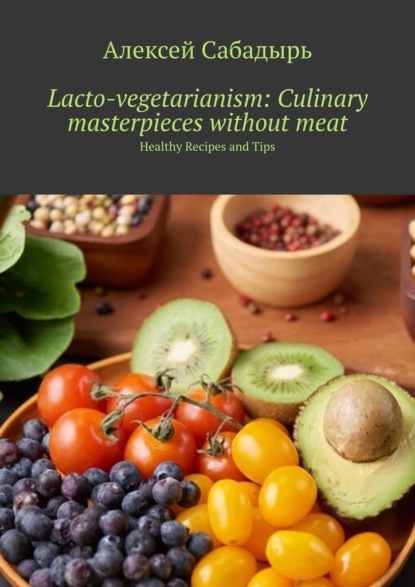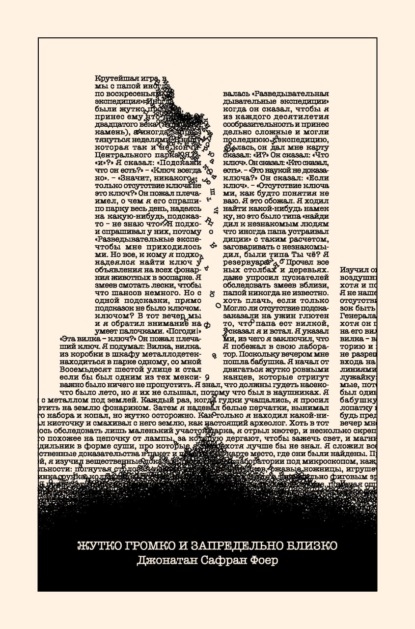
Текст
отзывы: 0 | рейтинг: 0
Lacto-vegetarianism: Culinary masterpieces without meat. Healthy Recipes and Tips
Алексей Сабадырь
The book is a collection of innovative and delicious recipes for those who follow a plant-based lifestyle without giving up dairy products. The author offers flavorful dishes that satisfy the body’s needs for protein, vitamins and minerals. Choiceand cooking ingredients, making it an essential resource for beginners and lacto-vegetarians.Ridero and the author of the book are not responsible for the information provided. Please contact your healthcare provider.
Lacto-vegetarianism: Culinary masterpieces without meat
Healthy Recipes and Tips
Алексей Сабадырь
© Алексей Сабадырь, 2023
ISBN 978-5-0062-0929-9
Created with Ridero smart publishing system
Chapter 1. Introduction to Lacto-Vegetarianism: History, Basic Principles and Benefits
Lacto – vegetarianism is a lifestyle and diet that is based on the consumption of plant foods and dairy products, excluding meat and fish. This lifestyle has a rich history in which people across cultures and times have chosen vegetarianism as a way to achieve health and spiritual harmony.
The history of lacto-vegetarianism stretches back thousands of years. Already ancient Indian texts such as the Vedas mention a vegetarian diet as a path to spiritual practice and mindfulness. In various religious traditions, many followers practice vegetarianism as a sign of respect for animals and the principle of non-creation. In today’s world, more and more people are paying attention to nutrition and its impact on the health of the planet.
The basic principles of lacto-vegetarianism include the consumption of fruits, vegetables, grains, legumes, nuts, seeds and dairy products, excluding meat, fish, poultry and products derived from them. This approach to nutrition helps provide the body with all the nutrients it needs while reducing the harmful effects of animal fats and cholesterol.
The benefits of being a lacto-vegetarian include improved health, including a reduced risk of heart disease, a boosted immune system, and reduced inflammation in the body. In addition, choosing lacto-vegetarianism can have a positive impact on the environment, as this lifestyle reduces the consumption of natural resources and harmful emissions from livestock farming.
In this book, we look at various aspects of the lacto-vegetarian diet, including health, ethical issues, recipes, and practical tips, to help you understand and participate in this lifestyle.
Chapter 2: Lacto-Vegetarian Diet Basics
A lacto-vegetarian diet is a diet that excludes meat, poultry and fish, but includes dairy products and eggs. This type of diet is an excellent choice for people who want to improve their health by following a vegetarian lifestyle while still getting the essential nutrients found in dairy products and eggs.
Eating healthily on a lacto-vegetarian diet requires some knowledge of nutrients that may be missed due to the lack of meat in the diet. In this book, we’ll look at how to get all the nutrients you need on a lacto-vegetarian diet to stay healthy and active.
In the first part of the book, we will look at the basic principles of healthy eating on a lacto-vegetarian diet, including recommendations for the consumption of proteins, fats, carbohydrates, vitamins and minerals. We will figure out which products can replace elements missing from the diet, and how best to consume them.
We’ll then look at the main nutrient groups – proteins, fats and carbohydrates – and find out which foods on a lacto-vegetarian diet can provide the body with essential vitamins and minerals such as vitamin B12, iron, zinc and calcium. We’ll also discuss how to prepare balanced meals that contain all the right nutrients while still being delicious and satisfying.
We conclude this chapter by providing practical guidance for meal planning on a lacto-vegetarian diet and sharing tips for choosing quality, fresh foods that will help you get all the nutrients you need.
Chapter 3: Lacto-Vegetarian Breakfasts
A vegetarian diet involves the absence of meat, fish and seafood, but allows the consumption of dairy products. Preparing delicious, filling and healthy breakfasts as part of a lacto-vegetarian diet can be surprisingly simple. In this chapter, we’ll look at three breakfast options that will help you start your day with a healthy, balanced meal.
Omelette with vegetables
Ingredients:
2 eggs
1/4 cup chopped tomatoes
1/4 cup chopped spinach
1/4 cup chopped mushrooms
1/4 cup grated cheese
salt and pepper to taste
olive oil
Preparation:
In a bowl, beat eggs with salt and pepper.
Heat a frying pan over medium heat, add olive oil.
Pour the beaten eggs into the pan and wait until they begin to set at the edges.
Top with tomatoes, spinach, mushrooms and cheese.
Wait until the cheese begins to melt, then carefully fold the omelette in half and serve hot.
Buckwheat porridge with berries and almond milk
Ingredients:
1 cup buckwheat porridge
2 cups almond milk
1/2 cup fresh berries (strawberries, raspberries, blueberries, etc.)
1/4 cup chopped almonds
honey or maple syrup for serving
Preparation:
Rinse the buckwheat and boil in almond milk until the porridge is soft.
Transfer the porridge to a plate and top with fresh berries and chopped almonds.
Serve with honey or maple syrup if you want to add sweetness.
Avocado toast with fresh vegetables
Ingredients:
2 slices full grain bread
1 ripe avocado
1 tomato, chopped
1 cucumber, chopped
Juice of half a lemon
Fresh green herbs (dill, parsley or cilantro)
Salt and pepper to taste
Preparation:
Toast full grain bread.
Mash the avocado pulp in a bowl, add salt, pepper and lemon juice.
Spread avocado onto toasted bread and top with sliced tomato and cucumber.
Sprinkle fresh green herbs on top and serve.
These breakfasts will not only be delicious, but also an energizing way to start your day. Enjoy the taste and nutritional value of each dish, and remember that self-care begins on the plate!
Chapter 4: Lacto-Vegetarian Diet Recipes: Three Meals
A lacto-vegetarian diet is a diet that excludes meat, poultry and fish, but includes dairy products. It differs from a regular vegetarian diet in that it allows the consumption of milk, yogurt, cheese and other dairy products. This diet is extremely healthy and allows you to get all the necessary nutrients.
Lunch is an important time to eat, so we offer you three lunch options as part of a lacto-vegetarian diet.
Light salad with buckwheat and vegetables.
To prepare this lunch you will need:
Алексей Сабадырь
The book is a collection of innovative and delicious recipes for those who follow a plant-based lifestyle without giving up dairy products. The author offers flavorful dishes that satisfy the body’s needs for protein, vitamins and minerals. Choiceand cooking ingredients, making it an essential resource for beginners and lacto-vegetarians.Ridero and the author of the book are not responsible for the information provided. Please contact your healthcare provider.
Lacto-vegetarianism: Culinary masterpieces without meat
Healthy Recipes and Tips
Алексей Сабадырь
© Алексей Сабадырь, 2023
ISBN 978-5-0062-0929-9
Created with Ridero smart publishing system
Chapter 1. Introduction to Lacto-Vegetarianism: History, Basic Principles and Benefits
Lacto – vegetarianism is a lifestyle and diet that is based on the consumption of plant foods and dairy products, excluding meat and fish. This lifestyle has a rich history in which people across cultures and times have chosen vegetarianism as a way to achieve health and spiritual harmony.
The history of lacto-vegetarianism stretches back thousands of years. Already ancient Indian texts such as the Vedas mention a vegetarian diet as a path to spiritual practice and mindfulness. In various religious traditions, many followers practice vegetarianism as a sign of respect for animals and the principle of non-creation. In today’s world, more and more people are paying attention to nutrition and its impact on the health of the planet.
The basic principles of lacto-vegetarianism include the consumption of fruits, vegetables, grains, legumes, nuts, seeds and dairy products, excluding meat, fish, poultry and products derived from them. This approach to nutrition helps provide the body with all the nutrients it needs while reducing the harmful effects of animal fats and cholesterol.
The benefits of being a lacto-vegetarian include improved health, including a reduced risk of heart disease, a boosted immune system, and reduced inflammation in the body. In addition, choosing lacto-vegetarianism can have a positive impact on the environment, as this lifestyle reduces the consumption of natural resources and harmful emissions from livestock farming.
In this book, we look at various aspects of the lacto-vegetarian diet, including health, ethical issues, recipes, and practical tips, to help you understand and participate in this lifestyle.
Chapter 2: Lacto-Vegetarian Diet Basics
A lacto-vegetarian diet is a diet that excludes meat, poultry and fish, but includes dairy products and eggs. This type of diet is an excellent choice for people who want to improve their health by following a vegetarian lifestyle while still getting the essential nutrients found in dairy products and eggs.
Eating healthily on a lacto-vegetarian diet requires some knowledge of nutrients that may be missed due to the lack of meat in the diet. In this book, we’ll look at how to get all the nutrients you need on a lacto-vegetarian diet to stay healthy and active.
In the first part of the book, we will look at the basic principles of healthy eating on a lacto-vegetarian diet, including recommendations for the consumption of proteins, fats, carbohydrates, vitamins and minerals. We will figure out which products can replace elements missing from the diet, and how best to consume them.
We’ll then look at the main nutrient groups – proteins, fats and carbohydrates – and find out which foods on a lacto-vegetarian diet can provide the body with essential vitamins and minerals such as vitamin B12, iron, zinc and calcium. We’ll also discuss how to prepare balanced meals that contain all the right nutrients while still being delicious and satisfying.
We conclude this chapter by providing practical guidance for meal planning on a lacto-vegetarian diet and sharing tips for choosing quality, fresh foods that will help you get all the nutrients you need.
Chapter 3: Lacto-Vegetarian Breakfasts
A vegetarian diet involves the absence of meat, fish and seafood, but allows the consumption of dairy products. Preparing delicious, filling and healthy breakfasts as part of a lacto-vegetarian diet can be surprisingly simple. In this chapter, we’ll look at three breakfast options that will help you start your day with a healthy, balanced meal.
Omelette with vegetables
Ingredients:
2 eggs
1/4 cup chopped tomatoes
1/4 cup chopped spinach
1/4 cup chopped mushrooms
1/4 cup grated cheese
salt and pepper to taste
olive oil
Preparation:
In a bowl, beat eggs with salt and pepper.
Heat a frying pan over medium heat, add olive oil.
Pour the beaten eggs into the pan and wait until they begin to set at the edges.
Top with tomatoes, spinach, mushrooms and cheese.
Wait until the cheese begins to melt, then carefully fold the omelette in half and serve hot.
Buckwheat porridge with berries and almond milk
Ingredients:
1 cup buckwheat porridge
2 cups almond milk
1/2 cup fresh berries (strawberries, raspberries, blueberries, etc.)
1/4 cup chopped almonds
honey or maple syrup for serving
Preparation:
Rinse the buckwheat and boil in almond milk until the porridge is soft.
Transfer the porridge to a plate and top with fresh berries and chopped almonds.
Serve with honey or maple syrup if you want to add sweetness.
Avocado toast with fresh vegetables
Ingredients:
2 slices full grain bread
1 ripe avocado
1 tomato, chopped
1 cucumber, chopped
Juice of half a lemon
Fresh green herbs (dill, parsley or cilantro)
Salt and pepper to taste
Preparation:
Toast full grain bread.
Mash the avocado pulp in a bowl, add salt, pepper and lemon juice.
Spread avocado onto toasted bread and top with sliced tomato and cucumber.
Sprinkle fresh green herbs on top and serve.
These breakfasts will not only be delicious, but also an energizing way to start your day. Enjoy the taste and nutritional value of each dish, and remember that self-care begins on the plate!
Chapter 4: Lacto-Vegetarian Diet Recipes: Three Meals
A lacto-vegetarian diet is a diet that excludes meat, poultry and fish, but includes dairy products. It differs from a regular vegetarian diet in that it allows the consumption of milk, yogurt, cheese and other dairy products. This diet is extremely healthy and allows you to get all the necessary nutrients.
Lunch is an important time to eat, so we offer you three lunch options as part of a lacto-vegetarian diet.
Light salad with buckwheat and vegetables.
To prepare this lunch you will need:
Другие книги автора:
Популярные книги
























